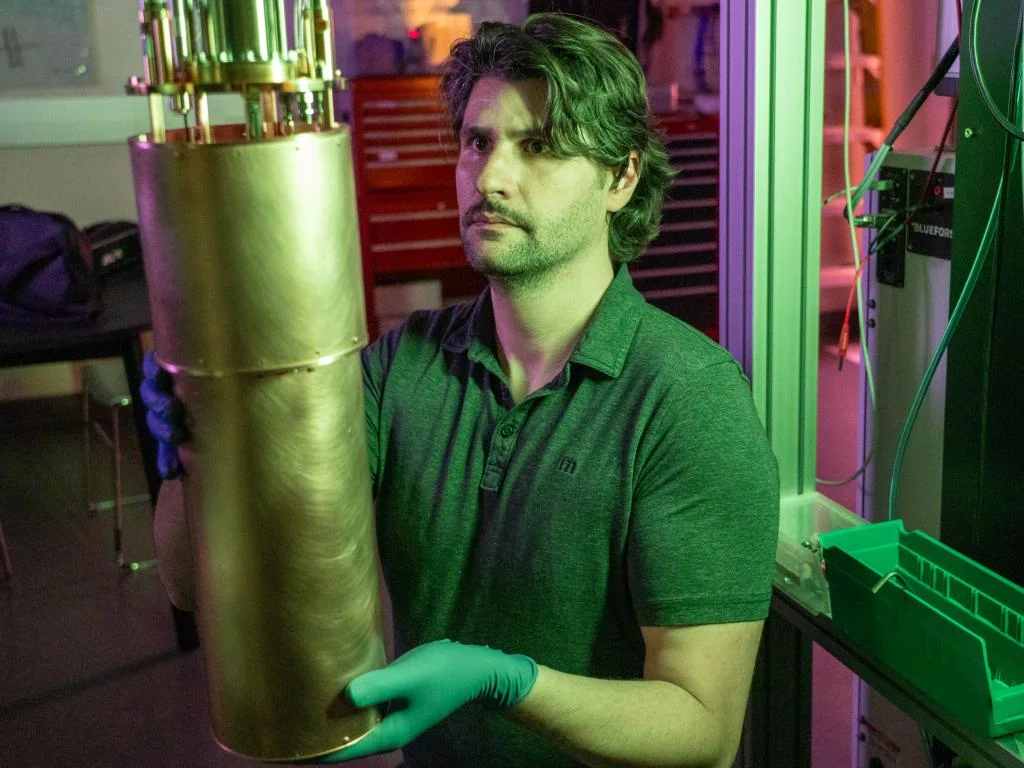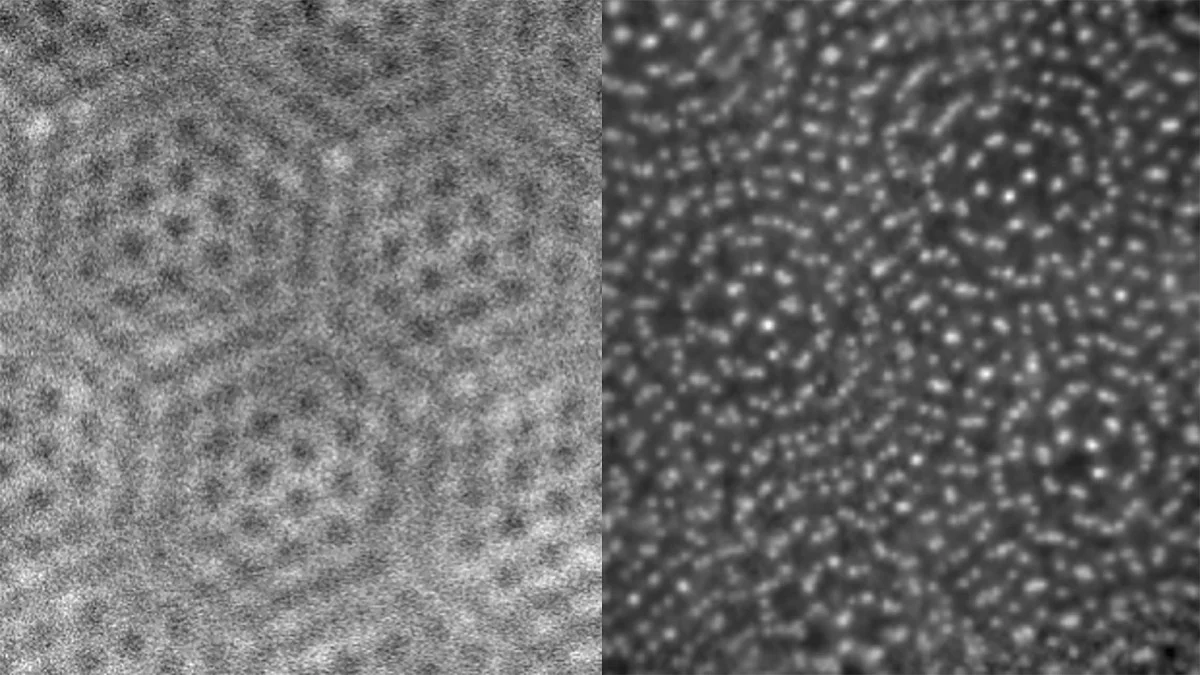Nik Zhelev, research assistant professor and director of the Quantum and Nanotechnology track for the Applied Physics master of science program, checks the fit of a shield fabricated from oxygen-free, high thermal conductivity copper he is attaching to a cryostat. The shield helps to further insulate the cryostat from light, heat, and vibrations. All photos by Kelley Christensen.
By Kelley Christensen
Office of the Vice President for Research and Innovation
In the Quantum Technologies Lab at the University of Oregon, researchers study electric circuits designed to behave as quantum objects at extremely cold temperatures. A quantum object is a photon that is in neither the 0 or 1 position of classical computing, nor the yes/no or on/off positions. Rather, a qubit, as they’re also called, is somewhere in between 0 and 1. This state of being multiple things at once is called superposition or a quantum mechanical state.
Studying circuits in superposition is of great interest to those hoping to propel computing capabilities into the next era, where parallel processing in that superposition state would enable computers to analyze data at speeds that make current computers appear positively sluggish by comparison.

But there’s a problem: To maintain a quantum mechanical state, qubits must be kept cold. Really, really cold—near absolute zero, which is when all atomic movement stops. The Quantum Technologies Lab, led by Nik Zhelev, research assistant professor and director of the Quantum and Nanotechnology track for the Applied Physics master of science program, using a tool called a dilution cryostat to study qubits at just barely above absolute zero.
But his team discovered that the off-the-shelf cryostat shielding couldn’t achieve the state of stillness—cold, dark, without vibrations or heat of any kind—needed to observe quantum bits (qubit for short) in action.
“To scale up the promise of quantum computing, we must account for quantum error correction: The poorer the quality of a qubit, the more exposed it is to light, heat, or vibration, the more qubits needed to encode information in the quantum mechanical state,” Zhelev said. “For quantum computing to have any value, it must, like classical computing, store data in memory that you can expect sometime later to find in the same state you left it. If after just a couple of milliseconds that information is scrambled, the need for error correction mounts, rapidly becoming very complicated. Our research seeks to improve the materials and design to prevent decay.”
Enter the machinists at the Oregon Fabrication and Design core research facility, who designed and created a bespoke shield from oxygen-free, high thermal conductivity copper to improve the conditions at which Zhelev and his lab study qubits. The copper shield screws into place around the cryostat’s vacuum chamber and the off-the-shelf shielding is placed around that, nesting-doll style.
In Two Places
At Once
Visit the quietest place in Oregon to learn more about quantum shielding in a choose-your-own-adventure tale of quantum silence.
“To create a good qubit, we need to minimize environmental effects so we are sensitive to the internal materials,” Zhelev said. “It’s our goal that with this additional shielding any losses we observe are due to the actual materials on the chip we fabricated, not stray infrared radiation. Once we achieve that, we can work with circuits that operate at energies at their quantum limit. In that limit, these macroscale circuits behave as artificial atoms—we can treat the macroscale circuit as a quantum object, which is usually only reserved to atomic-scale objects.”
Zhelev is working with Eli Bayarsaikhan, a student in the quantum master’s program, who has helped to build the first generation of what will he and Zhelev hope will lead to a superconducting quantum bit chip they’re developing.
The chip hosts the qubits, which are invisible to all but the most advanced microscopes. To interact with the qubits, the researchers send radio frequency pulses through a series of wires, circulators, and filters before passing through the superconducting qubit chip. The researchers measure the return
These capabilities are just one reason that the UO was selected by the National Science Foundation in 2024 to serve as one of six sites speeding the development of quantum technologies.
“Once we have confirmed that our quantum bit works as expected, we can tune the frequency and length of the radio-frequency pulses we send to the quantum bit and switch its state 0 to 1, 1 to zero, or unlike digital bits, we can also produce state which exists as some combination of 0 or 1,” Zhelev said. “In such a ‘quantum superposition’ state, the actual state of the quantum bit is only determined upon measurement, with us only able to tune the probabilities of each outcome.”
Such states allow for a different way of building computer architecture out of quantum bits with the promise of building quantum computers, which are expected to offer speed up processing times with regards to certain algorithms that researchers hope will include, but are not limited to, simulating properties of new materials, pharmaceuticals, and more.
“The reason why we don’t currently have such quantum computers is because the quantum bits we currently make only stay in the ‘quantum superposition’ state for a fraction of a second,” he said. “In our lab, we study how we can extend that time by optimizing the materials, geometry, and fabrication processes that make these qubit chips.”



